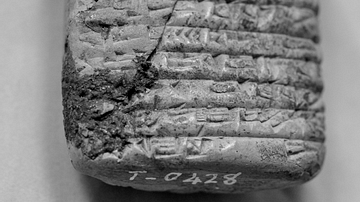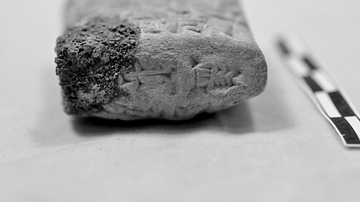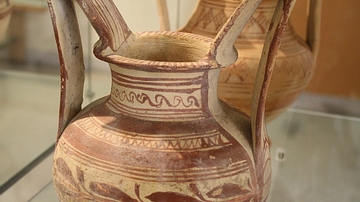Search Images
Browse Content (p. 1237)

Image
Illegally Excavated Mesopotamian Clay Tablet
This clay tablet was illegally excavated. The precise provenance of the excavation is unknown, but probably from Southern Mesopotamia, modern-day Iraq. It is currently housed in the Sulaymaniyah Museum, Iraqi Kurdistan.

Image
End View, Illegally Excavated Mesopotamian Clay Tablet
This clay tablet was illegally excavated. The precise provenance of the excavation is unknown, but probably from Southern Mesopotamia, modern-day Iraq. It is currently housed in the Sulaymaniyah Museum, Iraqi Kurdistan.
![Illegally Excavated Mesopotamian Clay Tablet [2]](https://www.worldhistory.org/img/c/p/360x202/7098.jpg?v=1599475502)
Image
Illegally Excavated Mesopotamian Clay Tablet [2]
This clay tablet was illegally excavated. The precise provenance of the excavation is unknown, but probably from Southern Mesopotamia, modern-day Iraq. It is currently housed in the Sulaymaniyah Museum, Iraqi Kurdistan.
![Illegally Excavated Mesopotamian Clay Tablet [11]](https://www.worldhistory.org/img/c/p/360x202/7094.jpg?v=1599475502)
Image
Illegally Excavated Mesopotamian Clay Tablet [11]
This clay tablet was illegally excavated. The precise provenance of the excavation is unknown, but probably from Southern Mesopotamia, modern-day Iraq. It is currently housed in the Sulaymaniyah Museum, Iraqi Kurdistan.
![Illegally Excavated Mesopotamian Clay Tablet [4]](https://www.worldhistory.org/img/c/p/360x202/7099.jpg?v=1599475502)
Image
Illegally Excavated Mesopotamian Clay Tablet [4]
This clay tablet was illegally excavated. The precise provenance of the excavation is unknown, but probably from Southern Mesopotamia, modern-day Iraq. It is currently housed in the Sulaymaniyah Museum, Iraqi Kurdistan.
![Illegally Excavated Mesopotamian Clay Tablet [6]](https://www.worldhistory.org/img/c/p/360x202/7100.jpg?v=1599475503)
Image
Illegally Excavated Mesopotamian Clay Tablet [6]
This clay tablet was illegally excavated. The precise provenance of the excavation is unknown, but probably from Southern Mesopotamia, modern-day Iraq. It is currently housed in the Sulaymaniyah Museum, Iraqi Kurdistan.
![Illegally Excavated Mesopotamian Clay Tablet [3]](https://www.worldhistory.org/img/c/p/360x202/7101.jpg?v=1599475503)
Image
Illegally Excavated Mesopotamian Clay Tablet [3]
This clay tablet was illegally excavated. The precise provenance of the excavation is unknown, but probably from Southern Mesopotamia, modern-day Iraq. It is currently housed in the Sulaymaniyah Museum, Iraqi Kurdistan.
![Illegally Excavated Mesopotamian Clay Tablet [9]](https://www.worldhistory.org/img/c/p/360x202/7102.jpg?v=1599475503)
Image
Illegally Excavated Mesopotamian Clay Tablet [9]
This clay tablet was illegally excavated. The precise provenance of the excavation is unknown, but probably from Southern Mesopotamia, modern-day Iraq. It is currently housed in the Sulaymaniyah Museum, Iraqi Kurdistan.

Image
Terracotta Aphrodite, Brundisium
A terracotta figurine depicting Aphrodite emerging from a shell, Brundisium, southern Italy. 3rd century BCE. (Archaeological Museum of Brindisi, Italy)

Image
Two-handled Vase, Brundisium
The two-handled pottery vessel (trozella) which was unique to the Messappian culture of southern Italy. 5th century BCE, Brundisum, southern Italy. (Archaeological Museum of Brindisi, Italy)